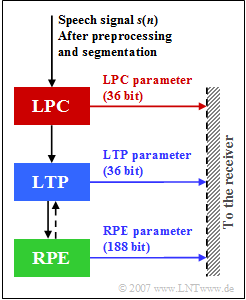Exercise 3.4Z: GSM Full-Rate Voice Codec
This codec called GSM Fullrate Vocoder (which was standardized for the GSM system in 1991) stands for a joint realization of coder and decoder and combines three methods for the compression of speech signals:
- Linear Predictive Coding (LPC),
- Long Term Prediction (LTP), and
- Regular Pulse Excitation (RPE ).
The numbers shown in the graph indicate the number of bits generated by the three units of this FR speech codec per frame of $20$ millisecond duration each.
It should be noted that LTP and RPE, unlike LPC, do not work frame by frame, but with sub-blocks of $5$ milliseconds. However, this has no influence on solving the task.
The input signal in the above graphic is the digitalized speech signal $s_{\rm R}(n)$.
This results from the analog speech signal $s(t)$ by
- a suitable limitation to the bandwidth $B$,
- sampling at the sampling rate $f_{\rm A} = 8 \ \rm kHz$,
- quantization with $13 \ \rm Bit$,
- following segmentation into blocks of each $20 \ \rm ms$.
The further tasks of preprocessing will not be discussed in detail here.
Notes:
- This exercise belongs to the chapter Gemeinsamkeiten von GSM und UMTS.
- Reference is also made to the Chapter Sprachcodierung des Buches „Beispiele von Nachrichtensystemen”.
Questionnaire
Sample solution
(1) To satisfy the sampling theorem, the bandwidth $B$ must not exceed $ f_{\rm A}/2 \hspace{0.15cm}\underline{= 4 \ \ \rm kHz}$.
(2) The given sampling rate $f_{\rm A} = 8 \ \rm kHz$ results in a distance between individual samples of $T_{\rm A} = 0.125 \ \rm ms$.
- Thus a speech frame of $(20 {\rm ms})$ consists of $N_{\rm R} = 20/0.125 = \underline{160 \ \rm samples}$, each quantized with $13 \ \rm Bit$.
- The data rate is thus
- $$R_{\rm In} = \frac{160 \cdot 13}{20 \,{\rm ms}} \hspace{0.15cm} \underline {= 104\,{\rm kbit/s}}\hspace{0.05cm}.$$
(3) The graph shows that per speech frame $36 \ {\rm (LPC)} + 36 \ {\rm (LTP)} + 188 \ {\rm (RPE)} = 260 \ \ \rm Bit$ are output.
- From this the output data rate is calculated as
- $$R_{\rm Out} = \frac{260}{20 \,{\rm ms}} \hspace{0.15cm} \underline {= 13\,{\rm kbit/s}}\hspace{0.05cm}.$$
- The compression factor achieved by the full rate speech codec is thus $104/13 = $8.
(4) Only the first two statements are true:
- The 36 LPC–bits describe a total of eight filter coefficients of a non-recursive filter, whereby eight acf–values are determined from the short-term analysis and where these are converted into reflection factors $r_{k}$ after the so-called Schur recursion.
- From these the eight LAR–coefficients are calculated according to the function ${\rm ln}[(1 - r_{k})/(1 + r_{k})]$, quantized with a different number of bits and sent to the receiver.
- The LPC output signal has a significantly lower amplitude than its input $s_{\rm R}(n)$, and it has a significantly reduced dynamic range and a flatter spectrum.
(5) Correct are the the statements 1 and 3, but not the second:
- Die LTP–Analyse und –Filterung erfolgt blockweise alle $5 \ \rm ms$ (40 Abtastwerte), also viermal pro Sprachrahmen.
- Man bildet hierzu die Kreuzkorrelationsfunktion (KKF) zwischen dem aktuellen und den drei vorangegangenen Subblöcken.
- Für jeden Subblock werden dabei eine LTP–Verzögerung und eine LTP–Verstärkung ermittelt, die am besten zum Subblock passen.
- Berücksichtigt wird hierbei auch ein Korrektursignal der nachfolgenden Komponente „RPE”.
- Bei der Langzeitprädiktion ist wie bei der LPC der Ausgang gegenüber dem Eingang redundanzvermindert.
(6) Richtig sind die Aussagen 2 und 3:
- Dass die Aussage 1 falsch ist, erkennt man schon aus der Grafik auf der Angabenseite, da $188$ der $260$ Ausgabebits von der RPE stammen. Sprache wäre schon allein mit RPE (ohne LPC und LTP) verständlich.
- Zur letzten Aussage: Die RPE sucht natürlich die Teilfolge mit der maximalen Energie. Die RPE–Pulse sind eine Teilfolge (13 von 40 Abtastwerte) zu je drei Bit pro Teilrahmen von $5 \ \rm ms$ und dementsprechend $12 \ \rm Bit$ pro $20 \ \rm ms$–Rahmen.
- Der „RPE–Pulse” belegt somit $13 \cdot 12 = 156$ der $260$ Ausgabebits.
Genaueres zum RPE–Block finden Sie auf der Seite RPE–Codierung des Buches „Beispiele von Nachrichtensystemen”.
